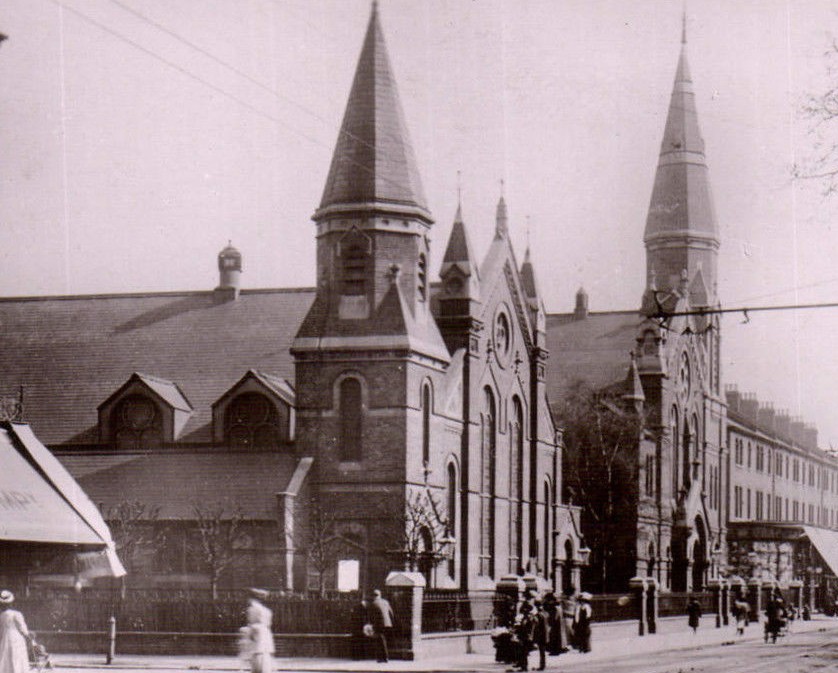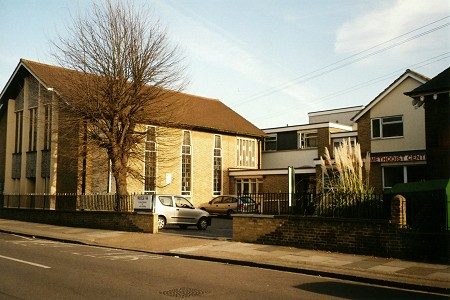Methodism
Seven Contemporary Churches
There are seven Methodist congregations with 700 members in Newham.
FOREST GATE Woodgrange Road, E7
HIGH STREET SOUTH East Ham E6
KEIR HARDIE Plymouth Road, Canning Town E16
MANOR PARK Herbert Road E12
PILGRIMS WAY East Ham Congregational and Methodist Church, E6
STRATFORD Bryant Street E15
STRATFORD NEW TOWN Windmill Lane E15

Past History
The Methodist Church traces its roots as a denomination to the work of John Wesley in the 18th century, but there is no evidence that a Methodist society was founded in Newham until the end of the18th century. Eventually there were three connections or branches in the now united English Methodism. They were known as: WESLEYAN, PRIMITIVE and UNITED. Individual churches in the Newham story are listed and identified within their own distinctive flow by W, P or U.
All re-united from 1932. The Victoria County History of Essex recorded an over-all total of 41 Methodist chapels or churches built in Newham- 24 in West Ham and 17 in East Ham. Methodist societies using them grew from 'cottage meetings', preaching missions and evangelism. Services were famous for the preaching and the singing, Congregations, or societies, were grouped in circuits and led by ministers.
When the three Methodist connexions came together in 1933 there were 18 or19 churches in West Ham and 11 in East Ham. Amalgamations were hastened by war with congregations decimated by evacuation and buildings destroyed by bombs. Redevelopment and population movement have further changed both buildings and membership.
Methodist churches known to have been in Newham are set out in chronological order within the three original branches and under the County Boroughs of West Ham and East Ham. All have their own distinctive story and only basic details are set out here.
Two Leading Methodists
Richard Blair, minister and leader of the Primitive Methodists between 1874 and 1904, was instrumental in building five new churches in West Ham and then three in East Ham. An open air preacher and evangelist he wrote 'Reaching the Masses' and 'Pulling Down and Building Up'
Jack Hart MBE, 1913-2010, was a member of East Ham Central Hall and then Pilgrims Way church. He served the area as councillor from 1935-90, first in the County Borough of East Ham, becoming Mayor and Leader and then in the London Borough of Newham from 1965 as deputy leader and then Leader 1976-85.
Wesleyan Methodist Churches in West Ham
STRATFORD was the first. Premises were situated in High Street, Chapel Street and The Grove in succession. A chapel was built in 1790 in High Street and in the 1820s a building was used between Chapel Street and Bridge Road. In 1828 the Wesleyans bought the former Unitarian building in Chapel Street but in 1851 there were only 80 in the congregation.
In the 1860's the church revived and grew and in 1871 a new imposing church was built in The Grove with 1000 seats. Missions followed in Abbey Lane, 1876-1940, and the Workmen's Hall, West Ham Lane from 1866. Membership grew from 281 in 1887 to 413 in 1910.
The Grove church was renamed Stratford Central Hall in 1919 with 262 members. In 1930, with 187 members, Stratford Methodists joined the London Mission.
The church was bombed in 1940 and the congregation halved by evacuation and in 1941 the remaining members joined the nearby Conference Hall. The building was demolished in 1953 with money ported to new churches in Southend and Harold Hill
EBENEZER Green Street, Plaistow E13 was said to have been built in 1825 but it closed a few years later with debt.
BARKING ROAD Canning Town E16 Opened in 1857 with services in Sabberton Street. Services, Sunday school and a day school were later held in Hallsville Road. Owned a building in 1862 with 250 seats and in 1868 acquired a bigger building and had 150 members. Fire destroyed this in 1887 but it was rebuilt and flourished until the 1930s. Bombed in 1940, the congregation used a temporary building until 1948. In 1957 membership was 50 and in 1960 the church moved to the new church at Fife Road.
HIGH STREET Plaistow E13 Originated in 1867 with a chapel registered in 1870 in Richmond Street. In 1880 a 900-seater new church was built in High Street. Membership grew from 303 in 1904 to 408 in 1914. But in 1940 it was 141 with 81 members evacuated and in 1941 a bomb destroyed the building. Services continued in the near-by Given-Wilson Institute to 1942 and then the remaining congregation joined Harold Road (U) in 1962. The site is now flats.
STRATFORD NEW TOWN E15 began in 1870 when Chapel Street members started services in Chandos Road and transferred later to the Mechanics Institute in Store Street. Newtown was attached to The Grove church until 1919. From 1919 to1939 it majored on youth work, leading to a sports ground at Lambourne End.
NORTH WOOLWICH Albert Road, Silvertown. E16 Started in 1870 from missions conducted from Woolwich. In 1871 a small building was erected and replaced in 1914 with an iron church. Membership was never large: 1904-28, 1911-51, 1916-22, 1936-12. The church was closed in 1939, damaged by bombs in 1943, opened again in 1949, and finally closed in 1959 and the site was sold.

WOODGRANGE ROAD Forest Gate E7. Began in 1878 when the Stratford circuit erected an iron building in a growing residential area. In 1881-2 a permanent building housed the church which by 1903 was the largest Protestant congregation in West Ham. It remained strong through the 1930's with an 800 congregation in 1939. Bombed in the war, the congregation moved to Field Lane (U) and was joined by Upton Lane (P). In 1956 a dual purpose hall was built on the Woodgrange site with the Katherine Road (U) East Ham and Clinton Road (P) congregations. In 1962 a new church was built with an external figure of an evangelist and a foundation stone with the five local uniting societies named.
GERMAN Star Lane, Canning Town E16 was built in 1890 for sugar refinery workers Membership in 1903 was 19 but the Germans left on the outbreak of the 1914-18 war. After usage by the un-denominational Tyrell Chapel between 1916 and 1924, the building passed to Canning Town Peculiar People, now the Evangelical Church.
HOREB WELSH Cumberland Road E13 was opened in 1915 with under 50 members; it was sold in 1939 to the Spiritualist church. The Welsh Methodist Society took over Sibley Close E6
TIDAL BASIN ROAD Canning Town E16 Registered in 1926 it had ceased by 1935
Wesleyans in East Ham
EAST HAM CENTRAL HALL Barking Road E6 opened in 1906. It replaced a previous church that began in 1870 with an iron church in Kelly Road (now Market Street). In 1880 a brick church was erected in Barking Road. From 1904 to 1906 interim services were held in the adjacent Town Hall before the 2000-seater Central Hall opened. By 1911 the church was crowded out with the largest Sunday morning congregation in Methodism together with a Men's Brotherhood of 3000 and a Sunday School of 1700. The church had strong political involvement- Jack Hart, leader of East Ham and then Newham Council in the 1960s and 1970s was a member. Even in 1967 it had 337 members but the church was demolished in 1969 and the hall sold to Newham Council and the members joined the Congregationalists to create the Pilgrims Way church.
UPTON PARK Green Street E7 began 1882, built a larger church in 1893-4 which by 1904 had 261 members but only 68 in 1962.
MANOR PARK Romford Road E12 started in 1890 with Wesleyan Methodists from Forest Gate holding services at Durham Cross, Manor Park. An iron building was followed by a large brick church in 1900 and a school hall was added in 1907. In 1934 the society amalgamated with the Herbert Road congregation. The church was sold in 1937
ABBOTS PARK Arragon Road E6 Started in 1891-2 to serve the Abbots Road housing estate and closed in 1904 as part of the preparation for the nearby Central Hall. The building was acquired by the Anglicans in 1905 and re-erected at Norman Road as a Sunday School for St. Mary Magdalene and is now the church hall
Primitive Methodists in West Ham
The 'Prims' arrived in Newham in the mid 19th century. They had a key personality in Richard Blair (1874-1904) who had been influenced by the publication 'The Bitter Cry of Outcast London.' He built five new churches in Canning Town, Plaistow, West Ham, Custom House and Upton Lane, was superintendent of the circuit and then three in East Ham. He wrote two books: 'Reaching the Masses' and 'Pulling Down and Building up'
His approach is evident in quotations from Reaching the Masses published in1886:
'we attend to old practices-open air preaching, street processing, house to house visitation, and benevolent actions'.... 'in this district [Canning Town] we have about 150 indoor and outdoor licensed places where drunkards are made and hearts are broken...five publicans and beer sellers to one minister or missionary.'
EBENEZER Henniker Road Stratford E15. Started in 1849 and leased Ark chapel in1851. In 1863 Ebenezer chapel was built. In 1940 the building was under the un-denominational Crippled Fellowship. In 1961-2 it was demolished.
CANNING TOWN, Swanscombe Street (formerly Mary St) E16. The Primitive Methodists "missioned this uninviting locality in 1853 and in a hired house formed the first church, after having encountered much opposition." The first chapel built in 1859 with 170 seats, was replaced in 1877 by a new church in Mary Street with a 1000 seats with money from Blair and Duncan, owner of the sugar refinery. It was a large red brick church in Barking Road, between Beckton Road and Rathbone Street, with a permanent platform for outside preaching together with frequent street processions. By 1903 it was the largest Primitive Methodist church in the Borough. Bombed in 1943 it was later demolished.
CHAPEL STREET, STRATFORD E15. This work began with cottage services in 1867. The working class congregation bought the former Wesleyan chapel in Chapel Street in 1870. This was sold in 1906
COLNE STREET, PLAISTOW E13. Started in 1870 with services in Kelland Road Influenced by Blair, the congregation grew and by 1883 there was a small church in Charles Street. Membership was 30 when the church was bombed in 1940. The site was sold in 1960 and the money ported to Aveley, Essex.
WEST HAM PARK Stratford Road E15 was another Blair project. This started in 1876 through open air services, by 1877 a school-chapel was built and in 1896 a new church was opened. In 1940/41 it was bombed and in 1948 all the premises were demolished.
CUSTOM HOUSE Bridgeland Street E16. Launched in 1881 by Richard Blair through open air services. In 1882 a society was formed, in 1883 an iron church was erected in Frederick Road but burnt down in 1888. A brick building replaced it. The church escaped bombing and received remnants of the Canning Town congregation and the Shirley Street church (U). Eventually all went to Fife Road. The Bridgeland Street building was demolished in 1966
CLINTON ROAD Forest Gate E7. Opened in 1882-3, starting as an offshoot of Ebenezer, it joined Woodgrange in 1959.
UPTON LANE Forest Gate E7. Initiated by Blair, the congregation was formed in 1889 and a church built in 1892. It closed in 1940 and the members joined Field Road. In 1966 the building was a clothing factory
STEELE ROAD Plaistow E13. The chapel was built in 1896 and closed in 1922.
Primitive Methodists In East Ham
NORTH WOOLWICH Woodman Street E16. Started in 1867 with services in a cottage, took over a shop, then under an archway between two houses and eventually put up a brick church in 1880. This was bombed in 1939-45 war and not rebuilt.
HIGH STREET SOUTH. Initiated in 1872 with home services in Mountfield Road conducted in a room by a worker from Beckton Gasworks. Richard Blair erected a temporary wooden building in 1880. In 1885 brick buildings were erected and stood until 2006 when a new church was built within a Springboard housing association complex. Membership in 1895 was 57 and in 1965 it was 152.

BECKTON Winsor Terrace E6. This started with cottage meetings in 1875 and services continued in a building erected by the Gas Light and Coke Company. Services were still taking place in 1901
ELIZABETH FRY MEMORIAL Plashet Grove E6. Richard Blair started services in 1884 in the Juvenile Mission Room in Crescent Road, then, with financial help from the Quakers in 1889, erected a church building carrying the name of a leading Quaker. By 1893 there were 103 members and three attached preaching stations. In 1934 it was bought by the Assemblies of God after the Methodist re-union.
MANOR PARK Sixth Avenue E12. Started in 1886 in an iron building and in 1901 moved into a brick church. In 1963 it joined the other Manor Park Methodists (formerly Wesleyan) in the Romford Road E12. The buildings went to the Anglicans in Little Ilford and were used by the Little Eye Youth Club before an African congregation, Celestial Church of Christ, 7th Year Parish took over in 1992.
BOLEYN ROAD E6. In 1886 this was an un-denominational mission. The Primitive Methodists bought it in 1893 and were still using it in 1907 but had ceased to so by 1923. Later it became Latimer Hall Chapel with Shaftsbury Society connections.
KATHERINE ROAD E6. An iron building in 1903 was still there in 1912. In 195, the congregation joined Woodgrange.
United Methodists In West Ham
WESLEY ASSOCIATION Stratford E15. Dates back to 1838 with a site near Bow Bridge on the south side of High Street. Although it had 200 members in 1851 in 1857 it was sold to the Unitarians. The congregation joined Bridge Road
BRIDGE ROAD Stratford E15 was a secession from Chapel Street in 1852.The church was registered in 1854 and a new building was erected in 1860. It closed in 1907 but in 1924 the building was used by an un-denominational group. In 1930 the Elim Four Square Gospel Alliance- one of the new Pentecostal movement- began to use.
SHIRLEY STREET Canning Town E16. First met in 1853 in Coke Oven Cottages on the site of Thames Iron Works. By 1860/61 there was a small church in Victoria Dock Road. A new church was built in 1873 in Shirley Street. This was bombed in 1940 and the members went to Canning Town until that was bombed and then all went to the Custom House church. Finally, everything was taken over by Fife Road in 1960 The Shirley Street site was sold for housing.
FIELD ROAD Forest Gate E7. Began in1861 and built a school chapel in 1863 before the large 500-seater church in 1870. Declined in the early 20th century but was renovated in 1930. During the war the Woodgrange and Upton Lane congregations shared the building. The congregation finally united with Woodgrange Road in 1956 with four other local societies. Flats are now on the site.
HAROLD ROAD, Plaistow E13. Registered in 1868, by 1881 it had 90 members, grew between 1889 and 1902 and in 1903 built a new church for 650. In 1914 membership was 130 but in 1939 it had dropped to 30. The congregation shrank in the war and then the High Street church took over the premises in 1942. It became the headquarters of the Newham Community Renewal Programme in 1975. The Moravian Church also used the building.
CONFERENCE HALL West Ham Lane, Stratford E15 became Methodist in 1934. The 1600-seater building had been used by the Mizpah group of 300 converts from the Moody and Sankey mission of 1884. The main hall was destroyed in 1941 and the congregation moved to Bryant Street when a new church was built on the site in the 1960s with some residential accommodation.

FIFE ROAD Canning Town E16. This church was built in 1960 replacing the buildings and re-uniting the congregations of Barking Road (W), Shirley St (U) and Custom House (P)
United Methodists in East Ham
MANOR PARK Herbert Road E12. Met in a disused beer-shop in Greenhill Road around 1870 first and then in a skittle alley. The first building was in 1880 and a larger church was rebuilt in 1891. This was rebuilt in 1964 with funds raised by the sale of the Sixth Avenue (P) church. It was badly damaged by fire in 2003 and the congregation worshipped in the adjacent hall until a new building opened in 2009.
TENNYSON AVENUE Manor Park E12. Opened in 1894, premises extended in 1899-1900 and closed in 1948.
KATHERINE ROAD East Ham E6. The church, built in1907, seated 1150 people and was filled in its first year. It was bombed in 1941. The church closed in 1957 after the remnant congregation joined with four other societies at Woodgrange Road E7
SIBLEY ROAD WELSH METHODIST E6 came from Cumberland Road, Plaistow in 1945 and took over the premises from the Welsh Congregationalists.
